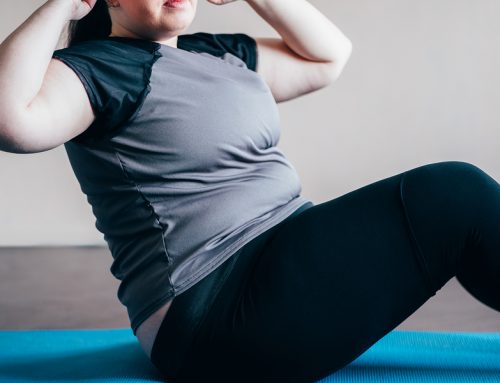“Prolonged sitting is making you fat and slowly KILLING YOU!” In the past several years, the media has been broadcasting warnings like this about the health risks of sitting too much. Maybe the headlines have been a bit sensationalistic, but the research is there, and now there’s another twist to the story: Newer studies say that even if you work out regularly, if you have a sedentary job where you spend all day long sitting in a chair, and you also sit all night at home, you may still be at risk.
 Experts are now saying that too much time spent sitting is an independent risk factor for obesity and metabolic health problems separate and distinct from getting too little exercise.
Experts are now saying that too much time spent sitting is an independent risk factor for obesity and metabolic health problems separate and distinct from getting too little exercise.
Physiologically, there are distinct effects between prolonged sedentary time and too little exercise time. Research has shown that chronic unbroken periods of muscular unloading associated with prolonged sedentary time can have negative biological consequences.
Even though the calories you burn while standing still are very low, standing elicits electromyographic and hormonal changes. NASA has done extensive zero gravity research showing the metabolic consequences of extreme muscular unloading and there are interesting parallels being drawn here.
Physiologically, it has been suggested that that loss of local muscle stimulation (contraction) due to sitting leads to suppressed skeletal muscle lipoprotein lipase activity and glucose uptake. By contrast, the mere act of standing involves isometric contraction of the anti-gravity (postural) muscles. Yet in the past, standing still would have been called “sedentary” behavior.
There’s another new wrinkle in the story: The latest research also suggests that you could meet what is considered an ideal guideline for physical activity, but if you also sit for extremely long periods, there could still be negative consequences. In other words, your formal workouts may not undo some of the negative consequences of long periods of sitting.
They have actually coined a name for this phenomenon – “THE ACTIVE COUCH POTATO”
An example is the person who works out regularly, or even jogs or bikes to and from work, but who sits all day long at his job for 8 or more hours and then spends several hours watching TV or surfing the internet in the evening.
One study found a strong association between metabolic risk and TV watching time even when physical activity was 150 minutes per week of moderate to vigorous exercise. They also said that this association may be stronger in women than in men.
Because these types of studies only show associations, it’s difficult to say with certainly that too much sitting specifically causes adverse health consequences. However, better scientific measurement with tools such as accelerometers has given us more insights than the older studies that were based only on surveys of self-reported TV and sitting time.
It’s also difficult and always has been, for health organizations to make broad physical activity guidelines for the entire general population.
Nevertheless, the latest research is pushing fitness experts and public health officials to send more messages that include not only guidelines on how much and what kind of formal exercise to do, but also to specifically reduce sedentary behaviors like TV watching and computer time.
They’re also calling for a distinction between too much sedentary time (particularly sitting) and too little exercise. In particular, they’re recommending that you break up sitting time whenever that’s possible.
Researchers in the Australian Diabetes, Obesity and Lifestyle Study found beneficial associations in metabolic risk markers just from the presence of breaks in sedentary time. That could be as simple as transitioning from sitting to standing or from standing still to starting to walk. They also found an association between a higher number of breaks in sitting time and beneficial changes in waist circumference, BMI, triglycerides and blood glucose.
When news reports hit the media previously about the sitting – obesity – health connection, some people shrugged it off as common sense or inconsequential. However, I think the idea that you might be an “active couch potato” is not something to shrug off at all, because unless you do formal workouts in addition to holding a physically-active job, the active couch potato group includes the majority of fitness-conscious people in our modern, technologically-based society today.
Many people work out diligently at least a few days per week, but they sit behind a desk for 8 hours without more than a lunch and bathroom break or two, and then when they get home, it’s straight for the couch/TV or the computer/internet.
A strong focus on nutrition and portion control can ensure weight loss despite a low activity level, but according to these latest findings, a minimalist workout program may not be enough to overcome all the negative health effects of an otherwise sedentary lifestyle.
I do agree that some of the news headlines can be a bit over the top (“Sitting is killing you!”). But considering the increasing amount of time people are spending on the computer/internet, and the way technology has changed all of our lives since the obesity crisis started to escalate, I believe this is a message we should take seriously.
This got my attention on a personal level because it wasn’t so long ago that my lifestyle changed in a way that put me behind a desk and in front of a computer even more than most nine to fivers.
For nearly a decade and a half, I worked in health clubs, where I was up on my feet and on the gym floor the majority of the day, as a personal trainer and club manager. When I became a full-time writer, researcher, author and internet publisher, I found myself glued to a desk and computer screen for 10-12 hours a day, sometimes longer.
Many people agree that too much sitting time is a legitimate concern, but have responded to this latest health news with exasperation because they feel trapped by virtue of their 9 to 5 desk jobs. We are a knowledge and technology-based society today and we’re not going backwards to a predominantly labor-based society any time in the near future.
But that’s not something to get frustrated about. I’m now in the same boat as many other people, but I’ve stayed in shape with great health and so can you. The solutions are simple:
1. Break up your sitting time as much as possible.
If prolonged sitting time is unavoidable, at least get up out of your chair at regular intervals and stretch, do a few non-sweat-inducing exercises, or walk around a bit. You can set fitness trackers like a FitBit to nudge you on the hour to take a couple hundreds steps before returning to your chair. If you’re really stuck at your desk, at least stand up whenever you can, or even work at a standing desk.
2. Substitute sedentary leisure time with physical leisure time.
Take a portion of your sedentary leisure time, particularly TV and web surfing, and replace it with active but fun leisure activities like sports, recreation, house or garden work, physical hobby work and walking. (One of my favorites: watch most of your TV only while on a bike, treadmill or stepper. Seriously, why not?)
3. Increase your daily physical activity beyond the gym.
Think constantly about how you can move more and live a more active lifestyle – every single day. (Do some research on NEAT: non-exercise activity thermogenesis and consider using a pedometer (such as a fitbit) to track your daily steps. It can be a real eye-opener when you compare your daily step count to standards set by health organizations. Falling in the “sedentary” category is very unhealthy. This is the current “hierarchy of stepping”:
1. 5,000 steps per day or less (sedentary)
2. 5,000 – 7,499 steps per day (low active)
3. 7,500 – 9,999 steps per day (somewhat active)
4. 10,000 – 12,499 steps per day (active)
5. 12,500 steps per day or more (highly active)
4. Continue diligently with your formal training programs.
Include at least 3 weekly resistance training sessions and 2-3 moderate to intense cardio training sessions of your choosing. For health, experts today are recommending at least 150 minutes of moderate (intentional) exercise a week. That could be a 30-minute brisk walk 5 days a week. In my experience, when you get up around 5 or more hours of moderate to vigorous training every week, when combined with good nutrition, that’s a level where you start seeing a major impact not only on health but also on body composition, even if you have a desk job and otherwise sedentary lifestyle.
5. Remember, nutrition is priority #1.
It’s possible to out-eat even the most active lifestyle. If you’re active, but still struggling with body fat, then your nutrition may need an overhaul. You can learn more about fat-burning nutrition in Burn the Fat, Feed the Muscle.
One Final Tip:
For accountability and motivation, enter one of our Free Fitness challenges, like the 1 Million Step Challenge. Check out our contest calendar to see when the next event starts that you can enter: Burn the Fat Challenge Contest Calendar.
Tom Venuto,
Founder & CEO, Burn the Fat Inner Circle
Author of Burn the Fat, Feed the Muscle
Author of The BFFM Guide to Flexible Meal Planning For Fat Loss

Tom Venuto is a natural bodybuilding and fat loss expert. He is also a recipe creator specializing in fat-burning, muscle-building cooking. Tom is a former competitive bodybuilder and today works as a full-time fitness coach, writer, blogger, and author. In his spare time, he is an avid outdoor enthusiast and backpacker. His book, Burn The Fat, Feed The Muscle is an international bestseller, first as an ebook and now as a hardcover and audiobook. The Body Fat Solution, Tom’s book about emotional eating and long-term weight maintenance, was an Oprah Magazine and Men’s Fitness Magazine pick. Tom is also the founder of Burn The Fat Inner Circle – a fitness support community with over 52,000 members worldwide since 2006. Click here for membership details
Scientific References:
Too Much Sitting: The Population health Science of Sedentary Behavior, Owen, N. et al, Exercise and Sport Science Reviews, vol 38, No 3 pp 105-113, 2010
Medical Hazards of Prolonged Sitting, Basset DR, et al. Exercise and Sport Science Reviews, vol 38, No 3 pp 101-102, 2010
Objectively measured sedentary time, physical activity and metabolic risk: The Australian Diabetes, Obesity and Lifestyle Study (AusDiab), Diabetes Care, vol 21, no 2, pp 369-371, 2008.






I was shocked by this study when I read it the first time. However, it really makes the case for just getting up and walking more often. One of the best things for me was getting a dog that I take for 2 long walks. Keeps me away from the computer. When I’m sitting in my office, I almost always stand up for phone calls as well. Not only is it a good opportunity to stretch, but it also makes my voice louder and more confident. Thanks for the great info as always!
I would have never guessed that, I thought exercise would offset sitting issues but looks not and possibly irrelevant for an active couch potato ..another new term as well!Raymond
Interesting read. I was a complete couch potato until recently when I became an active couch potato (it would seem)!There is always the danger of accepting sitting around because of intense workouts at other times during the week for me, something I will now think a little more about and try to break the day up as you suggest.Thanks Tom
Another good reason to drink lots of water when sitting at the computer at work – you gotta get up regularly to pee, if nothing else!
So, what I’m hearing here is that unless I give up everything I love to go work in a factory, apparently, why bother working out? I’ve given up the overwhelming majority of the foods I’ve loved because I know that sugar is a big problem for me. I’ve cut back on quantity. No sweetened colas or soft drinks, etc.I don’t want to make my job (losing weight) harder, but I’m a writer, I have finally found something in writing which brings me great joy, and I’m not giving it up for any d**n study. Writing means that one sits. Programming means that one sits. So does graphic design.I’m just about to the point where I wonder why I bother. Every time I turn around, there’s something else I can’t eat, can’t do or can’t have. What’s the point?
There is some solution to sitting all day at a computer. Kitchen counter height requires you to stand so one can write and stand as some authors used to do. At work, I got a little riser/lift that my laptop can sit on, raising it to countertop height. When I had a back injury, I used it to stand all day long instead of sitting. After that when I am not actively working in the lab (lots of standing), I can use the riser/lift to break up the sitting.I like Arwen’s solution too. LOL.
I have recently come to the conclusion that this is one of the few remaining changes I can make to keep reducing! As a 49-year-old woman who religiously works out 6-7 days a week and am very careful with my diet, I remain disappointed that I cannot seem to shred that last 5 pounds that are only obvious to me and my mirror! I am hoping to experiment with a 3 to 5 minute interlude every hour to see if that makes a difference, like jumping jacks, running in place, etc.. Otherwise it’s chuck the computer, from which I have heard some suggest the EMF waves have contributed to their inability to lose weight – hmm, is it the EMF or is it the sitting? I hope to find out! Thanks for all of the good advice.
Is cycling sedentary?
titrant wrote, “Is cycling sedentary?” Not at all. cycling wouldn’t be sedentary in anyones definition of the word, just because you’re sitting. You’re pedaling against resistance, contracting musculature all over your body (especially the legs) and expending, potentially a large amount of calories. cycling while watching TV instead of watching tv sprawled on couch would make a huge difference for those who are active but work long hours behind a desk during the day
janice, make sure your nutrition is super-tight. In my experience, if youve successfully dropped a lot of fat already, and you’re down to that final bit of body fat – the last 5-10 lbs, being very strict with your nutrition makes a bigger difference than anything. But then again, every bit of activity helps!
janet, you wroteSo, what I’m hearing here is that unless I give up everything I love to go work in a factory, apparently, why bother working out?that wasnt the message at all. GO back and read the entire post again particularly the last 2 paragraphs and the 5 tips at the end.
Hey TomI am on my feet all day and walking around a lot. I lift and pull and do all kinds of different stuff related to my job. However I do spend my nights sitting on the computer as I do not watch much TV. I will keep this article in mind but I believe if one does nothing compared to one who works out daily or at least 3 time per week should have a better chance keeping metabolic problems at bay. As you may know metabolic syndrome has been linked to several diseases and especially heart disease. So in any case one must remain in motion and exert themselves though some type of physical activity on a daily basis!To your good health and vitality Russ
I work out every day and I try to get out for a walk after lunch. Along the National Mall- it is very nice.
A movement therapist I worked with once recommended working out a movement “phrase” that pleases you or serves you in some way (physically, emotionally, spiritually, whatever). Then get off your butt and “do” your “phrase” every so often, every hour or half hour or whatever interval works. I think I might pull this idea out of mothballs and dust it off.
Even i do weight training at least 3 days a week and do cardio 2 times, i was feeling inside sometimes something was wrong. Then i found myself that walking at least 20 to 30 minutes is necessary for health or health of all organs.Thanks for everything TOM
That’s very interesting and certainly new information to me (must’ve been acting like an ostrich when the research first came to light). I’d say I’m definitely an active couch potato, as I go to the gym and work hard most mornings, then come home and spend long hours on the computer entering competitions. I eat small, healthy meals 4 – 5 times each day and include protein with every one, but I still can’t budge that muffin-top. Now I have some new strategies to incorporate. Thank you very much from “Down Under”.
The rise of the sedentary office jobs! This study was quite an eye opener because I also was under the impression that exercise would offset and weight gain.Sometimes I am at the desk sitting down for up to 10 hours, as well as lifting weights 3 times per week I also do yoga every day and I think this has been not only great for my posture but also for keeping my metabolism steady. Every break I get through the day I do a few stretches as well.So I guess I am an active yogic couch potato!
I have been thinking about the dangers of too much sitting for a few years now, ever since I read that taxi drivers have a high rate of colon cancer. The only thing taxi drivers do that’s different to everyone else is sitting for long periods whilst (presumably) breathing traffic fumes. I can’t help but wonder if it’s a combination of those 2 unhealthy things that increases their risk. In the same way that heavy drinkers who also smoke at the same time have a much greater risk of oral cancers. Another very interesting article from Tom, thank you.
I have a desk job and I try to get up as much as I can, but at times its hard to do due to work load. Tom, can you tell me if there are any effective exercises you can do while sitting at your desk, every little bit helps. Thanks for all you do!
We humans, were just not made to sit of a computer all day long.But anyway, why not rope jump for a cople of minutes each hour? I’m thinking about doing that myself, as i sit for too long as well. The “guilt” feeling is coming to me.
In my opinion, there has to be an exercise threshold that would override the active couch potato effect.For example, if you worked out 2 hours per day, like Jack LaLanne, would you still be subject to the active couch potato calamities?What if you are an endurance athlete working out 1.5 hours per day?We need to establish the above mentioned threshold with a common denominator, such as METS. Then we could adjust our daily activity accordingly.
Palo wrote: “In my opinion, there has to be an exercise threshold that would override the active couch potato effect.” Im sure there is. I my post I Mentioned that for body comp (to ensure weight loss), you simply have to balance energy in vs energy out. Sitting all day long and being sedentary in your leisure time as well simply makes that difficult because many people over-estimate calories burned during their formal workouts and under-estimate calories burned from NEAT and leisure activities. As for undoing health and muscular effects of prolonged sitting, again, I’m sure there is a threshold too. I also suggested in my post above that when you get up to about 5 hrs a week or more, you can get pretty darn good results – not just for health but also body composition, even if you work a desk job for 8 hrs a day, as long as your nutrition is in order. One simply needs to adjust energy expended via exercise and energy intake from food, and be sure to include weight training and theres not much to worry about. However, all that said… if you work a desk job all day long AND you are sedentary at night too (TV watcher, web surfer), that is flat out not good for you and at large, the entire population in our western technology based society today is PROFOUNDLY sedentary
Similar to the comment on the height of kitchen counters… I recently got a “stand desk” for my office. I can easily move the computer screen, keyboard, and mouse over to the stand desk, and then work standing. Or move back when I want to sit. Good also for back pain, etc.
Thank you for the wake up call. Going on a walk now.
My 56 year old mum swears by sitting on a Swiss ball when she uses her computer – I laughed at her, then tried it and fell off (a lot). I seriously underestimated the amount of effort it takes to just stay upright!
A woman where I work sits on one of those big exercise balls. It’s still sitting of course, but at least there’s bouncing, rolling and balancing involved. Does that make a difference?
Great coverage of this study, Tom. I agree with your recommendations, and the best part is that they fit my intuition. I feel terrible if I sit for many hours a day without getting up but if I get up and move every hour or two my energy levels can be much more consistent and high.
Thanks, Tom, for all of the great advice you offered here. I am one who works out religiously 6 days a week, and find that I still struggle to get my body fat down to where it needs to be. I think that doing what you are suggesting (more movement during the day, watching my nutrition) will help me finally achieve my goals.
Recently I have been making a conscious decision to do computer crap for 20 mins, then change to moving around the house while cleaning or straightening up, and then gardening for the next twenty minutes, etc. The goal is to do this all day, every day, using different things around the house and outside to fill the blocks of time, but I’m human and sometimes I forget to reset my iphone timer and sit online far too long till I realise I have wasted a whole hour typing away. Whoops.
So, from now on, the kettlebell will be my new best computer desk friend. I will be sure to put it right in my face beside my laptop. ;-)